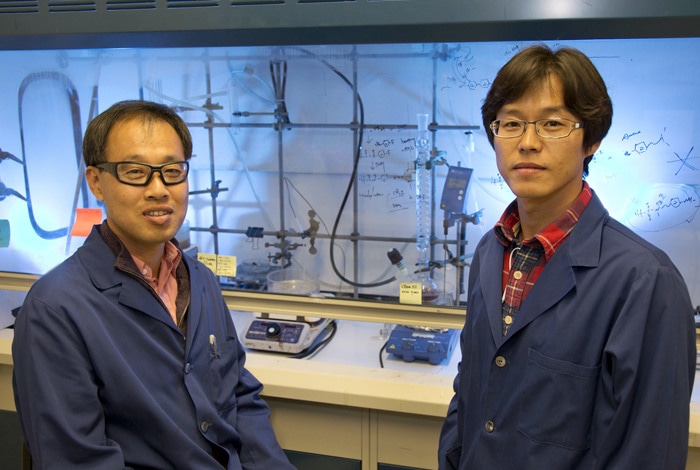Aug 24 2016
 Yu Seung Kim (left) and Kwan-Soo Lee (right)
Yu Seung Kim (left) and Kwan-Soo Lee (right)
A recent breakthrough to speed up the commercialization of low-cost fuel cells for stationary and automotive applications has been achieved by a team from Los Alamos National Laboratory in partnership with Yoong-Kee Choe at the National Institute of Advanced Industrial Science and Technology in Japan and Cy Fujimoto of Sandia National Laboratories.
The gap between the operating temperature ranges of two currently available polymer fuel cells can be bridged by a new class of fuel cells based on a new polymer-based material.
The team discovered that fuel cells produced from phosphate-quaternary ammonium ion-pair can be activated between 80°C and 200°C without and with water, improving the applications of these cells under varied conditions. The journal Nature Energy features this research.
Polymer-based fuel cells are regarded as the key technology of the future for both vehicle and stationary energy systems. There’s a huge benefit to running fuel cells at the widest possible operating temperature with water tolerance. But current fuel-cell vehicles need humidified inlet streams and large radiators to dissipate waste heat, which can increase the fuel-cell system cost substantially, so people have looked for materials that can conduct protons under flexible operating conditions. It is very exciting that we have now found such materials.
Yu Seung Kim, Los Alamos National Laboratory
Since the 1970s, Los Alamos has been recognized in the fuel-cell research field. Fuel cell technologies help reduce air pollution, greenhouse gas emissions, and oil consumption, which is a major benefit for nation’s economy, environment, and energy security.
The ongoing research extends its support to the Laboratory’s future missions associated with energy security and materials.
Two significant classes of polymer-based fuel cells are currently available. One is high-temperature fuel cells capable of operating up to 180°C without water. However, the performance level decreases under water-absorbing conditions below 140°C.
The other type is a class of low-temperature fuel cells that fail to work above 100°C and need water for proton conduction.
The researchers discovered that a phosphate-quaternary ammonium ion-pair possesses stronger interaction, which permits the transfer of protons even under water-condensing scenarios in an effective manner.
“The discovery happened when we were investigating alkaline hydroxide conducting membranes, which have quaternary ammonium groups. While the alkaline membranes work only under high pH conditions, the idea came across that alkaline membranes can be used under low pH conditions by combining with phosphoric acid. This was a breathtaking moment, when Choe brought the calculation data that showed the interaction between quaternary ammonium and biphosphate is 8.7 times stronger than conventional acid-base interaction.
Yu Seung Kim, Los Alamos National Laboratory
The Los Alamos team worked together with Fujimoto at Sandia in order to develop quaternary ammonium functionalized polymers. The prototype fuel cells produced from the ion-pair-coordinated membrane exhibited outstanding fuel-cell durability and performance at 80-200°C, which cannot be obtained with the currently available fuel cell technology.
In the future, “The performance and durability of this new class of fuel cells could even be further improved by high-performing electrode materials,” said Kim, quoting an advance expected within a span of five to ten years that is yet another significant step for replacing the existing low-temperature fuel cells used in stationary and vehicle applications.
Researchers involved in this project include Kwan-Soo Lee (Los Alamos National Laboratory, Chemistry Division), Jacob Spendelow, Yu Seung Kim (Los Alamos National Laboratory, Materials Physics and Applications Division), Yoong-Kee Choe (National Institute of Advanced Industrial Science & Technology, Japan), and Cy Fujimoto (Sandia National Laboratories).